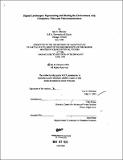| dc.contributor.advisor | Otto Piene. | en_US |
| dc.contributor.author | Oliveras, Iris N. (Iris Nereida) | en_US |
| dc.contributor.other | Massachusetts Institute of Technology. Dept. of Architecture. | en_US |
| dc.date.accessioned | 2012-02-29T17:18:04Z | |
| dc.date.available | 2012-02-29T17:18:04Z | |
| dc.date.copyright | 1993 | en_US |
| dc.date.issued | 1993 | en_US |
| dc.identifier.uri | http://hdl.handle.net/1721.1/69306 | |
| dc.description | Thesis (M.S.V.S.)--Massachusetts Institute of Technology, Dept. of Architecture, 1993. | en_US |
| dc.description | Includes bibliographical references (leaves 59-62). | en_US |
| dc.description.abstract | We understand the world through our senses. What we see, hear, touch-what we experience--is a construct of a reality that is individual, flexible and in motion. Our thoughts and behavior and the quality of our existence rests on perception of ourselves and our environments. We experience the world personally with the ability to 'edit' our experiences by denying, ignoring, enhancing or changing what we see. Technical developments have made it possible to experience environments that are already altered when they reach one's senses. Modem society is being shaped by the designed, pre-pakaged environment. Visual realities are now pre-fabricated, canned for consumption for an audience increasingly dependent on information fed by others. This thesis, plus its accompanying installation, is based on the premise that images shape thought and that the creative process of image-making can be used to learn about the living environment through video and computer graphics representations. The written part of the thesis examines the changing role of the individual and the artist in a world increasingly shaped by mass media. It proposes an alternate visual communications system for investigating and sharing living environments. The accompanying installation demonstrates the system's educational and creative potential through a visual exploration that plays with the notion of the reliability of perception. It opens a window on the creative process, transforming the artist's studio into a box of illusions and simulations that reflect the illusive nature of art. | en_US |
| dc.description.statementofresponsibility | by Iris N. Oliveras. | en_US |
| dc.format.extent | 62 leaves | en_US |
| dc.language.iso | eng | en_US |
| dc.publisher | Massachusetts Institute of Technology | en_US |
| dc.rights | M.I.T. theses are protected by
copyright. They may be viewed from this source for any purpose, but
reproduction or distribution in any format is prohibited without written
permission. See provided URL for inquiries about permission. | en_US |
| dc.rights.uri | http://dspace.mit.edu/handle/1721.1/7582 | en_US |
| dc.subject | Architecture. | en_US |
| dc.title | Digital landscapes : representing and sharing the environment with computers, video and telecommunications | en_US |
| dc.type | Thesis | en_US |
| dc.description.degree | M.S.V.S. | en_US |
| dc.contributor.department | Massachusetts Institute of Technology. Department of Architecture | |
| dc.identifier.oclc | 28735171 | en_US |
